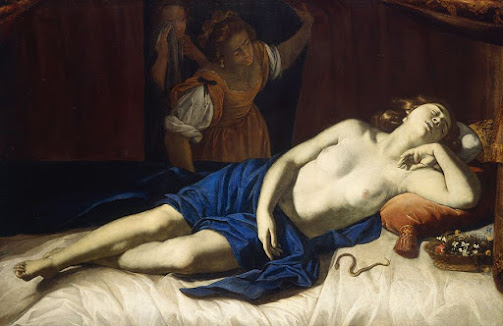"Artemisia" July 8, 1593-1654
Right now at London's National Gallery, there is a major
exhibition of 34 of the known 38 paintings of Artemisia Gentileschi,
the greatest female painter of the 17th century.
"Self-Portrait as Allegory of Painting"
She was proud of her talents and success.
"Self-Portrait Playing the Lute"
She was apparently gifted in many ways, including singing.
"Self-Portrait as St. Catherine of Alexandria"
with the wheel which was about to tear her to pieces.
Artemisia is the most celebrated female painter of the 17th century. She worked in Rome, Florence, Venice, Naples and London, for the highest echelons of European society, including the Grand Duke of Tuscany and Philip IV of Spain.
Artemisia was born in Rome, the eldest of five children and only daughter of Orazio Gentileschi, under whom she trained. Artemisia’s earliest signed and dated painting, ‘Susanna and the Elders’ is from 1610. A year later Artemisia was raped by the painter Agostino Tassi, an acquaintance and collaborator of her father’s. An infamous trial, meticulously recorded in documents that survive, ensued in 1612. Tassi was found guilty and banished from Rome, though his punishment was never enforced.
"Judith Beheading Holofernes" in Uffizi Gallery
The story is from the Old Testament about an Assyrian general
about to destroy a Hebrew army and town. Artemisia crept into
his tent at night, had a few drinks, and when he was drunk,
cut off his head to take back to the Hebrews to prove he was gone.
"Judith Beheading Holofernes" in Pitti Palace
Cutting off a head takes a lot of strength. This is a physically
powerful woman. Some critics read these paintings as
revenge for her rape.
"Judith and Maidservant with Head of Holofernes" Pitti Palace
The single candle, the hand shading it, the darkness of the
background, the dramatic contrasts of light and shadow are
all key marks of the Baroque style, which Artemisia helped create.
"Judith and Maidservant with Head of Holofernes" in Detroit Art Institute
Following the trial Artemisia married a little known Florentine artist by the name of Pierantonio di Vincenzo Stiattesi, and left Rome for Florence shortly thereafter. There she had five children and established herself as an independent artist, becoming the first woman to gain membership to the Academy of the Arts of Drawing in 1616. Artemisia returned to Rome in 1620, beset by creditors after running up debts, and she remained there for 10 years (except for a trip to Venice in 1628).
"Susana and the Elders" 1610
Painted when she was 17.
The story is from the Old Testament about two old men who
secretly watch a young woman bathing, then demand sex or they
will ruin her reputation. She refused. All Artemisia's women
subjects are strong heroines.
"Susana and the Elders"
She painted the subject several times; this one is much later.
"Mary Magdalen"
The sumptuous treatment of the fabric, the colors, the lights and
shadows are masterfully done. As a woman, Arte was forbidden
from seeing nude male models and sketching them. But she
knew the female body better than any male painter.
"Mary Magdalen in Ecstacy"
"Mary Magdalen"
From 1630 she settled in Naples, where she ran a successful studio until her death. She briefly visited London in 1639, perhaps to assist her ailing father on the ceiling painting of the Queen’s House in Greenwich (now at Marlborough House in London), but was back in Naples the following year. The precise date of her death is not known but a recently discovered document records her still living in Naples in August 1654.
"Cleopatra"
"Lucrezia"
Lucrezia was an ancient Roman matron who was raped by the
last king of Rome. She committed suicide rather than dishonoring
her family. The political outcry led to the end of the Roman Kingdom
and the beginning of the Roman Republic. Artemisia also
knew ancient history; she was well educated.
"Bathsheba at her Bath"
King David was a peeping Tom, spying on her.
The female flesh and form is Artemisia's specialty.
"The Annunciation"
She also painted large religious paintings.
"Adoration of the Magi"
"St. Cecelia Playing the Lute"
The play of light and shadow in the fabric, the dark background,
the spotlight effect on her face are all specially baroque.
St. Cecelia is the patroness of musicians.
__




















What an education! Never knew much of this about her. Thought Judith did it all by herself! Carrying off with his head... that would have been tough. Yuk
ReplyDeleteThank you for the sharing.